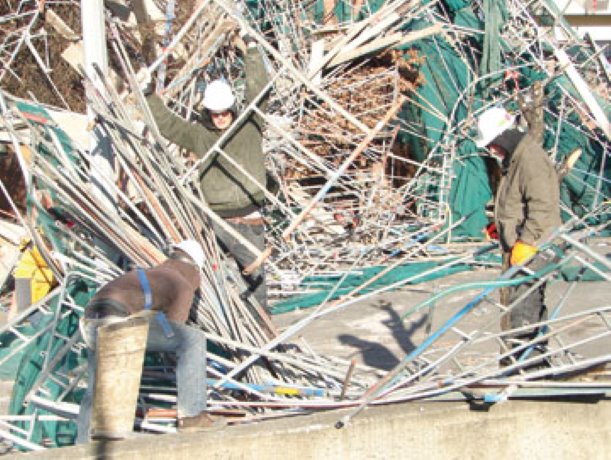Heavy gusts of wind ripped nine storeys of scaffolding from the side of a condominium in downtown Victoria Dec. 6.
Protective netting investigated for possible role in collapse
VICTORIA
Heavy gusts of wind ripped nine storeys of scaffolding from the side of a condominium in downtown Victoria Dec. 6.
“The scaffold was due to come down this week, but I guess it came down a little faster than expected,” Raymond Merriman, senior regional manager for WorkSafeBC said after the incident.
Parts of Vancouver Island experienced heavy winds that reached speeds of 30 to 60 kilometres an hour, with gusts to 90 km/h around the time of the incident.
The force of the winds caused a scaffold structure attached to the outside of Denby Place condominiums at 770 Cormorant Street to teeter wildly and collapse.
“The tenants heard a rumbling and the whole thing came down in one to two minutes,” said a security guard, who was sent to the scene to cordon off the area, but declined to give his name. The scaffold crashed to the ground in a large pile of twisted and broken poles, wooden planks and green netting.
Nobody was hurt in the incident, but a car was buried in the debris and several trees and a railing were damaged.
“Integrity Wall Systems is doing an incident investigation, which is standard protocol under the Workers Compensation Act,” said Merriman. “The investigation will look at, what the winds were like, who was the engineer and, what the scaffold was designed to do?”
The scaffolding was covered with green mesh or netting and that may have been a contributing factor to the collapse.
“Anytime netting is used on a vertical surface, it does act as a sail,” said Greg Baynton, president of the Vancouver Island Construction Association.
“Mesh is meant to pull out without pulling the scaffold down, when the wind reaches a certain velocity. All scaffolding has to be approved by an engineer for wind loading and should be designed to withstand a one-in-a-hundred year event.”
Baynton said an engineer would have to design a scaffold for winds of up to 50 or 60 kilometres per hour to meet this standard.
“Scaffolds can be engineered for a typical situation,” he said.
“But non-typical situations that are based on topography and the location of other buildings are difficult to plan for.”
The location of Denby Place may have contributed to the collapse because there seems to have been some sort of wind tunnel effect on Cormorant Street.
“Wind velocity intensifies at corners and in specific locations,” said Baynton.
“The wind also has a way of finding the weakest point of a scaffold. The winds were very serious and they caught everybody by surprise.”
Baynton said winds also create a problem on site for nailing down and securing anything that could fly away.
Despite this, he said there are very few incidents given the number of scaffolds in use. Merriman said Integrity Wall Systems was using the scaffold at Denby Place to do work on the exterior of the building.
Integrity responded immediately to the incident by sending crews to the scene to cut apart and untangle the twisted mess.
The scaffold poles and planks were sorted into piles, loaded on to trucks and removed from the street.
The cleanup operation was made more difficult by gusts of wind, which sent pieces of debris flying past workers.
According to Merriman, a remaining section of scaffolding was going to be taken down immediately using a forklift. A new scaffold will need to be built to repair holes in the side of the building where the collapsed scaffold structure was attached.
The scaffolding contractor was contacted, but would not comment on the incident.











Recent Comments
comments for this post are closed